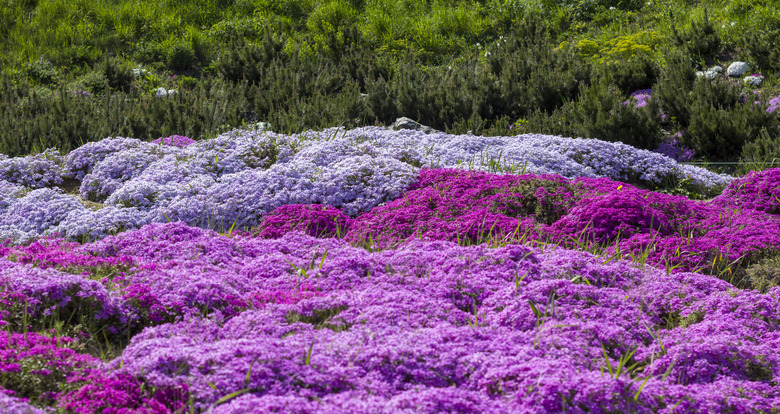How To Grow Creeping Phlox Groundcover
Even if you've never grown creeping phlox (Phlox spp.), you have probably seen and admired this perennial. Its dense and delicate foliage and vibrant spring flowers cover fields and climb up rock walls. Phlox are spring bloomers and begin flower production in March, but the compact, spreading foliage stays green almost all year long. That makes the plant an excellent and attractive lawn substitute and a ground cover for difficult areas. If you are wondering how to grow creeping phlox ground cover, you'll be happy to hear that the plant isn't very picky as long as it gets sun, well-draining soil and adequate irrigation.
Phlox Ground Cover
Phlox Ground Cover
Creeping phlox is an herbaceous perennial that is native to the eastern and central regions of the country. It grows as a semi-evergreen in U.S. Department of Agriculture plant hardiness zones 3 through 9, depending on species. That means that it can grow in all but the coldest and hottest areas of the United States.
Two primary creeping phlox species are Phlox subulata (zones 3-9) and Phlox stolonifera (zones 5-8). They're both short, spreading relatives of upright garden phlox (Phlox paniculata, zones 4-8). Sometimes plants are mistakenly referred to as "creeping flocks," and it's easy to see why. The innumerable tiny leaves and flowers seem to occupy soil like flocks of sheep. Creeping phlox takes a compact growth habit and forms mats of foliage that grow to about 6 inches tall.
Since the plants remain low-growing but spread quickly, they make great ground covers. You can plant creeping phlox ground cover on flat ground as a lawn substitute. But the plants are particularly practical and attractive on sloping ground where they help prevent erosion and also carpet the hillside with their vibrant spring flowers. On the downside, they can rapidly take over any empty fields nearby their original planting location, whether you want them to or not.
Growing Creeping Phlox
Growing Creeping Phlox
Creeping phlox grow best in sunny areas, although plants will also do well in areas of mixed sun and shade. If you plant them on a southern facing slope, they will flow down it quite quickly, even "lapping" beautifully onto a retaining wall at the base. Phlox is also an excellent plant to provide the backdrop for a stepping-stone pathway or fill in between the stones in rock gardens. In spring, the phlox froths up with pink, red, white or blue blossoms, creating a long-lasting and dramatic display with little effort on your part.
The plants prefer moist soil that is well-draining, so if you are planting creeping phlox as a ground cover, it's a good idea to work organic matter, such as compost, into the soil before planting. However, phlox will also grow in poor soil, dry areas, sandy earth, rocky sections and even clay, although it may not spread as quickly or flower as abundantly.
Caring for Creeping Phlox
Caring for Creeping Phlox
Phlox flowers arrive in spring, and the beautiful flowers attract equally beautiful butterflies to your garden. Keep the plants watered during dry periods for best results. The fragrant flowers last two or three months, often from March through May, and are truly lovely. Each blossom has five, flat, petal-like, rounded lobes, and all are notched. Note that the term "phlox" comes from the Greek word for flame, so expect exceptionally vibrant shades.
The primary work you'll need to do once your phlox is established is keeping the plants dense. That requires shearing of the phlox just after the blooming period is over. This type of haircut pushes the foliage to stay compact and dense for the summer months. It can also encourage the plants to flower again, a little later in summer. If you need more plants, you can propagate this type of phlox by dividing them just after they bloom.
